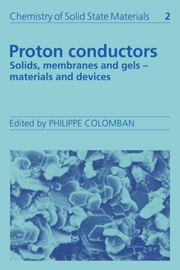Book contents
- Frontmatter
- Contents
- List of contributors
- Preface
- Symbols
- I HYDROGEN BOND AND PROTONIC SPECIES
- 1 The hydrogen bond and chemical parameters favouring proton mobility in solids
- 2 Protonic species and their structures
- 3 Proton conductors: classification and conductivity
- 4 Defects, non-stoichiometry and phase transitions
- 5 Structural studies of proton conductors
- 6 Hydrogen in metals: structure, diffusion and tunnelling
- II MATERIALS: PREPARATION, STRUCTURES AND PROPERTIES
- III PROTON DYNAMICS AND CHARGE TRANSPORT
- IV PROTON DIFFUSION MECHANISMS
- V DEVICES
- Index
4 - Defects, non-stoichiometry and phase transitions
Published online by Cambridge University Press: 04 May 2010
- Frontmatter
- Contents
- List of contributors
- Preface
- Symbols
- I HYDROGEN BOND AND PROTONIC SPECIES
- 1 The hydrogen bond and chemical parameters favouring proton mobility in solids
- 2 Protonic species and their structures
- 3 Proton conductors: classification and conductivity
- 4 Defects, non-stoichiometry and phase transitions
- 5 Structural studies of proton conductors
- 6 Hydrogen in metals: structure, diffusion and tunnelling
- II MATERIALS: PREPARATION, STRUCTURES AND PROPERTIES
- III PROTON DYNAMICS AND CHARGE TRANSPORT
- IV PROTON DIFFUSION MECHANISMS
- V DEVICES
- Index
Summary
Introduction
Protonic conduction can be considered as a particular case of ionic conduction; however, there are some similarities with electronic conduction because of the proton size. In both cases, defects can play an important role.
Ionic conductivity in a compact structure is generally very low and requires a high activation energy. The diffusion coefficient of oxygen in amorphous silica at 1000°C, for instance, is 10–14cm2 s–1 and that in MgO is 10–20 cm2 s–1, with activation energies between 1 and 4 eV. In single crystal and polycrystalline alumina at 1700 °C, the diffusion coefficient decreases to 10–15 and 10–12cm2 s–1, respectively, and the activation energy increases to 6–8 eV. The diffusion coefficients of smaller cations such as Al3+ are of the order of 10–9–10–10 cm2 s–1 with activation energy of about 5 eV.
The diffusion coefficient of Al3+ ions in interstitial sites can be obtained from electrical conductivity measurements. Its activation energy is considerably lower (2.5 eV) than that of lattice diffusion. This applies not only to Al3+ in alumina but generally to all atoms occupying defect sites. All compounds have naturally a certain number of intrinsic defects as well as those associated with impurities (extrinsic defects). Intrinsic defects can be thermally activated and are particularly important for non-stoichiometric compounds. In the latter, diffusion coefficients are generally higher and the activation energy lower than that in stoichiometric compounds.
- Type
- Chapter
- Information
- Proton ConductorsSolids, Membranes and Gels - Materials and Devices, pp. 61 - 78Publisher: Cambridge University PressPrint publication year: 1992



